Communication Strategies in Education: Autistic School Children Focus
VerifiedAdded on 2021/04/21
|12
|2906
|39
Essay
AI Summary
This essay explores the critical role of communication in educating autistic school children. It begins by defining communication and its various forms, emphasizing the importance of interpersonal and written communication in the classroom. The essay highlights the significance of a teacher's role in fostering effective communication, particularly considering the unique challenges faced by autistic students. It delves into the nuances of interpersonal communication, including the need for self-awareness, patience, and the ability to build relationships. The essay also examines the importance of written communication, including the use of visual aids and modern technologies. It addresses potential challenges, such as disruptive behaviors and sensory sensitivities, and stresses the need for teachers to collaborate with families and adapt teaching strategies accordingly. Furthermore, the essay underscores the importance of training teachers in effective communication tools and methods to ensure the educational needs of autistic children are met, and it concludes by emphasizing the power of building strong relationships with students to create a supportive learning environment.
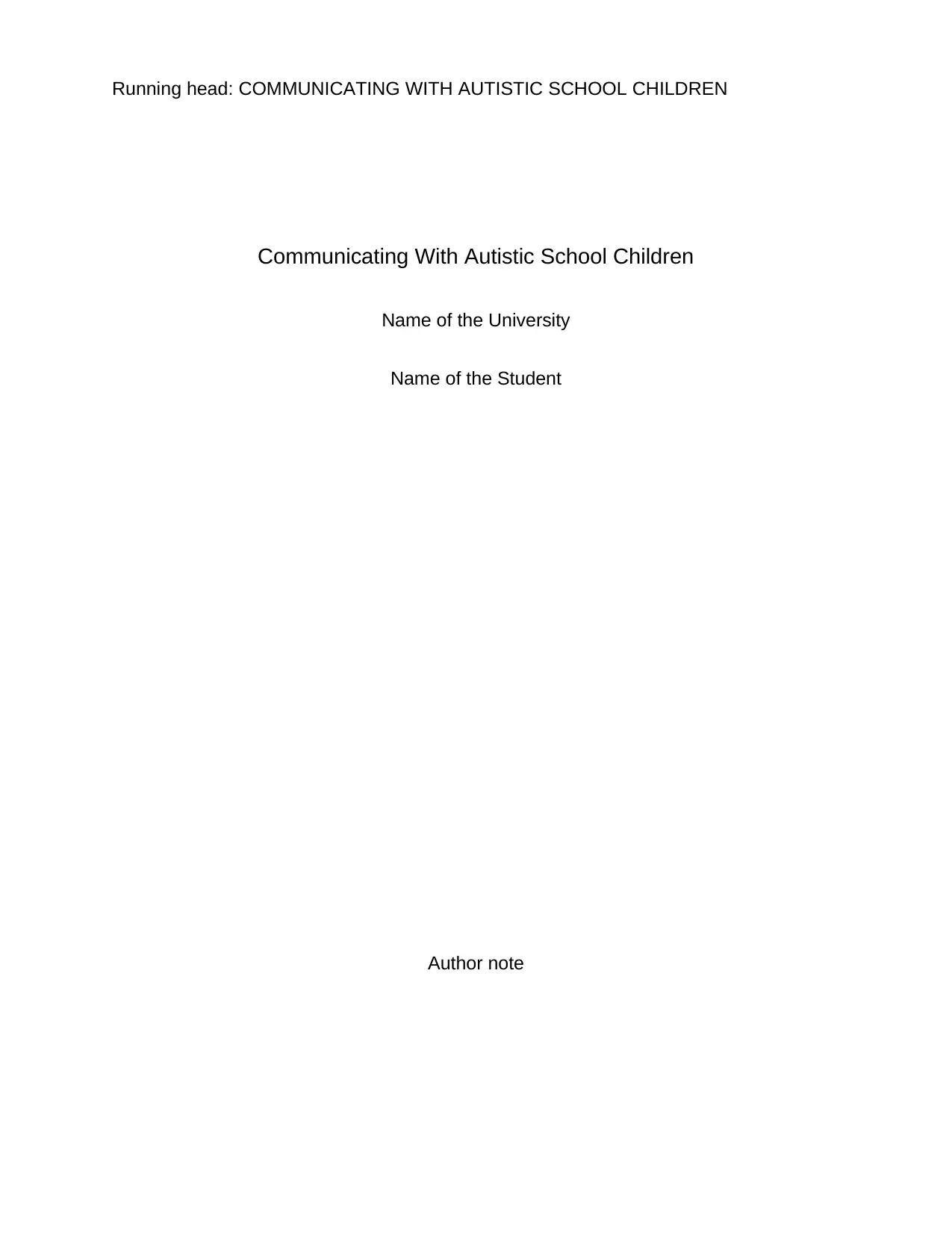
Running head: COMMUNICATING WITH AUTISTIC SCHOOL CHILDREN
Communicating With Autistic School Children
Name of the University
Name of the Student
Author note
Communicating With Autistic School Children
Name of the University
Name of the Student
Author note
Paraphrase This Document
Need a fresh take? Get an instant paraphrase of this document with our AI Paraphraser
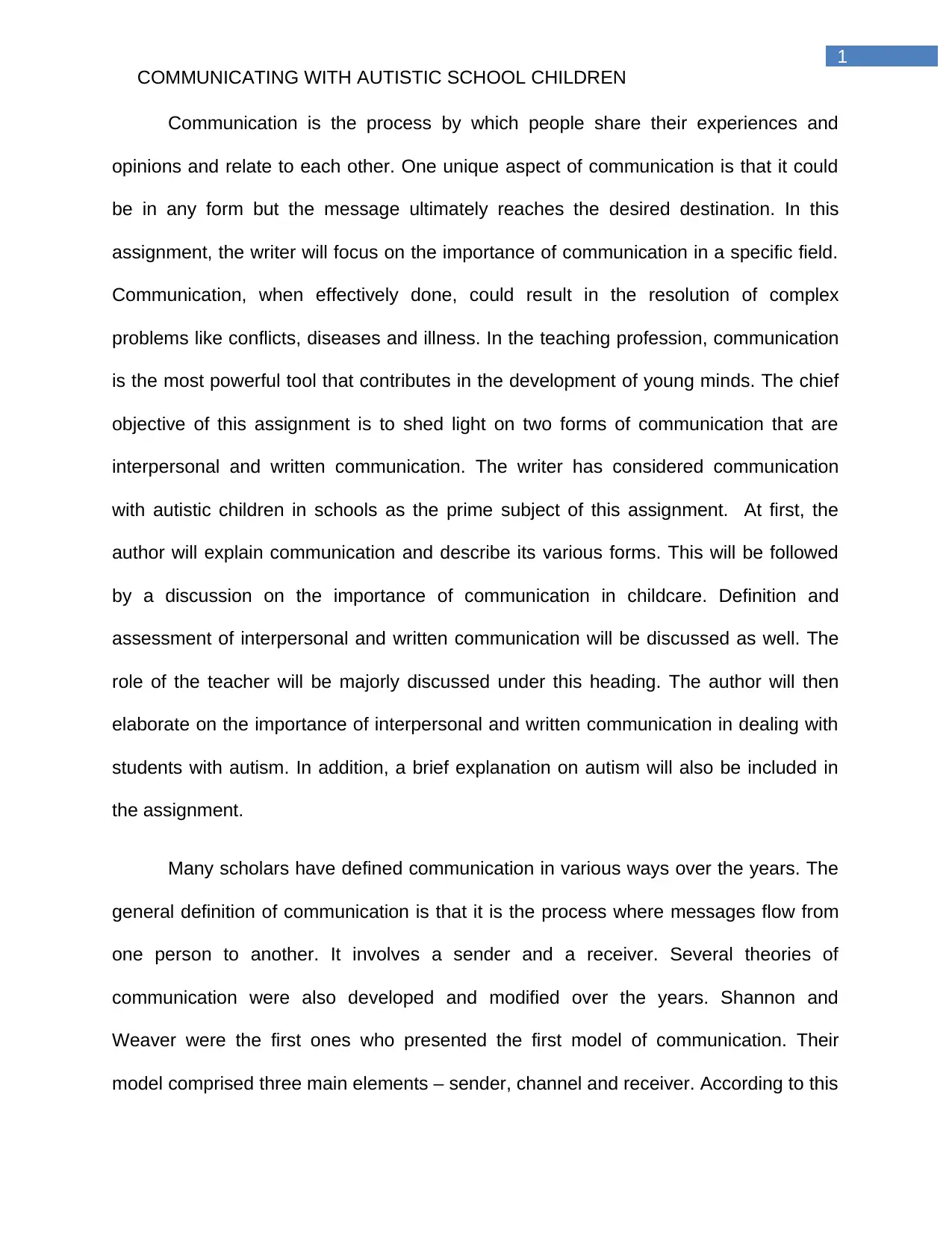
1
COMMUNICATING WITH AUTISTIC SCHOOL CHILDREN
Communication is the process by which people share their experiences and
opinions and relate to each other. One unique aspect of communication is that it could
be in any form but the message ultimately reaches the desired destination. In this
assignment, the writer will focus on the importance of communication in a specific field.
Communication, when effectively done, could result in the resolution of complex
problems like conflicts, diseases and illness. In the teaching profession, communication
is the most powerful tool that contributes in the development of young minds. The chief
objective of this assignment is to shed light on two forms of communication that are
interpersonal and written communication. The writer has considered communication
with autistic children in schools as the prime subject of this assignment. At first, the
author will explain communication and describe its various forms. This will be followed
by a discussion on the importance of communication in childcare. Definition and
assessment of interpersonal and written communication will be discussed as well. The
role of the teacher will be majorly discussed under this heading. The author will then
elaborate on the importance of interpersonal and written communication in dealing with
students with autism. In addition, a brief explanation on autism will also be included in
the assignment.
Many scholars have defined communication in various ways over the years. The
general definition of communication is that it is the process where messages flow from
one person to another. It involves a sender and a receiver. Several theories of
communication were also developed and modified over the years. Shannon and
Weaver were the first ones who presented the first model of communication. Their
model comprised three main elements – sender, channel and receiver. According to this
COMMUNICATING WITH AUTISTIC SCHOOL CHILDREN
Communication is the process by which people share their experiences and
opinions and relate to each other. One unique aspect of communication is that it could
be in any form but the message ultimately reaches the desired destination. In this
assignment, the writer will focus on the importance of communication in a specific field.
Communication, when effectively done, could result in the resolution of complex
problems like conflicts, diseases and illness. In the teaching profession, communication
is the most powerful tool that contributes in the development of young minds. The chief
objective of this assignment is to shed light on two forms of communication that are
interpersonal and written communication. The writer has considered communication
with autistic children in schools as the prime subject of this assignment. At first, the
author will explain communication and describe its various forms. This will be followed
by a discussion on the importance of communication in childcare. Definition and
assessment of interpersonal and written communication will be discussed as well. The
role of the teacher will be majorly discussed under this heading. The author will then
elaborate on the importance of interpersonal and written communication in dealing with
students with autism. In addition, a brief explanation on autism will also be included in
the assignment.
Many scholars have defined communication in various ways over the years. The
general definition of communication is that it is the process where messages flow from
one person to another. It involves a sender and a receiver. Several theories of
communication were also developed and modified over the years. Shannon and
Weaver were the first ones who presented the first model of communication. Their
model comprised three main elements – sender, channel and receiver. According to this
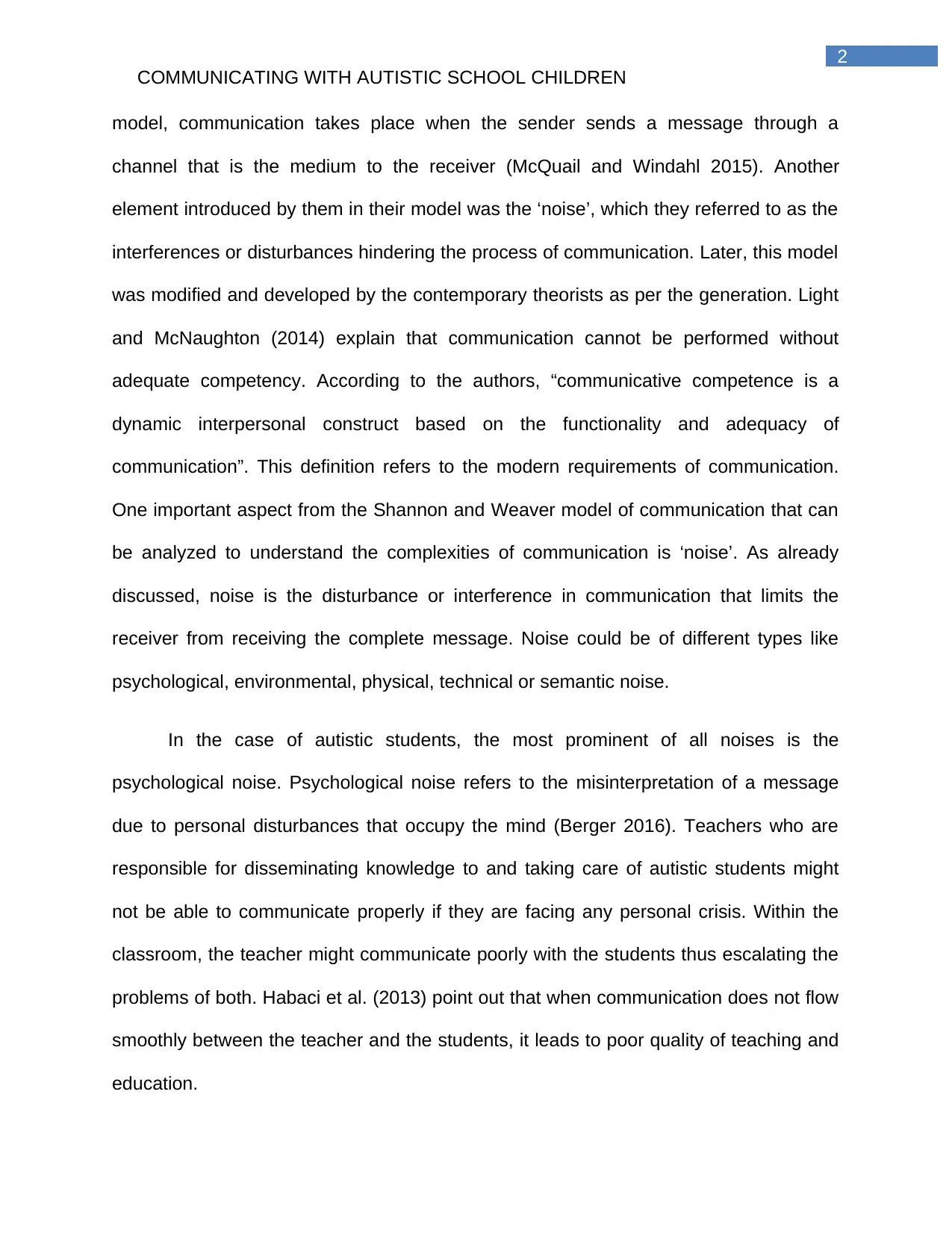
2
COMMUNICATING WITH AUTISTIC SCHOOL CHILDREN
model, communication takes place when the sender sends a message through a
channel that is the medium to the receiver (McQuail and Windahl 2015). Another
element introduced by them in their model was the ‘noise’, which they referred to as the
interferences or disturbances hindering the process of communication. Later, this model
was modified and developed by the contemporary theorists as per the generation. Light
and McNaughton (2014) explain that communication cannot be performed without
adequate competency. According to the authors, “communicative competence is a
dynamic interpersonal construct based on the functionality and adequacy of
communication”. This definition refers to the modern requirements of communication.
One important aspect from the Shannon and Weaver model of communication that can
be analyzed to understand the complexities of communication is ‘noise’. As already
discussed, noise is the disturbance or interference in communication that limits the
receiver from receiving the complete message. Noise could be of different types like
psychological, environmental, physical, technical or semantic noise.
In the case of autistic students, the most prominent of all noises is the
psychological noise. Psychological noise refers to the misinterpretation of a message
due to personal disturbances that occupy the mind (Berger 2016). Teachers who are
responsible for disseminating knowledge to and taking care of autistic students might
not be able to communicate properly if they are facing any personal crisis. Within the
classroom, the teacher might communicate poorly with the students thus escalating the
problems of both. Habaci et al. (2013) point out that when communication does not flow
smoothly between the teacher and the students, it leads to poor quality of teaching and
education.
COMMUNICATING WITH AUTISTIC SCHOOL CHILDREN
model, communication takes place when the sender sends a message through a
channel that is the medium to the receiver (McQuail and Windahl 2015). Another
element introduced by them in their model was the ‘noise’, which they referred to as the
interferences or disturbances hindering the process of communication. Later, this model
was modified and developed by the contemporary theorists as per the generation. Light
and McNaughton (2014) explain that communication cannot be performed without
adequate competency. According to the authors, “communicative competence is a
dynamic interpersonal construct based on the functionality and adequacy of
communication”. This definition refers to the modern requirements of communication.
One important aspect from the Shannon and Weaver model of communication that can
be analyzed to understand the complexities of communication is ‘noise’. As already
discussed, noise is the disturbance or interference in communication that limits the
receiver from receiving the complete message. Noise could be of different types like
psychological, environmental, physical, technical or semantic noise.
In the case of autistic students, the most prominent of all noises is the
psychological noise. Psychological noise refers to the misinterpretation of a message
due to personal disturbances that occupy the mind (Berger 2016). Teachers who are
responsible for disseminating knowledge to and taking care of autistic students might
not be able to communicate properly if they are facing any personal crisis. Within the
classroom, the teacher might communicate poorly with the students thus escalating the
problems of both. Habaci et al. (2013) point out that when communication does not flow
smoothly between the teacher and the students, it leads to poor quality of teaching and
education.
⊘ This is a preview!⊘
Do you want full access?
Subscribe today to unlock all pages.

Trusted by 1+ million students worldwide
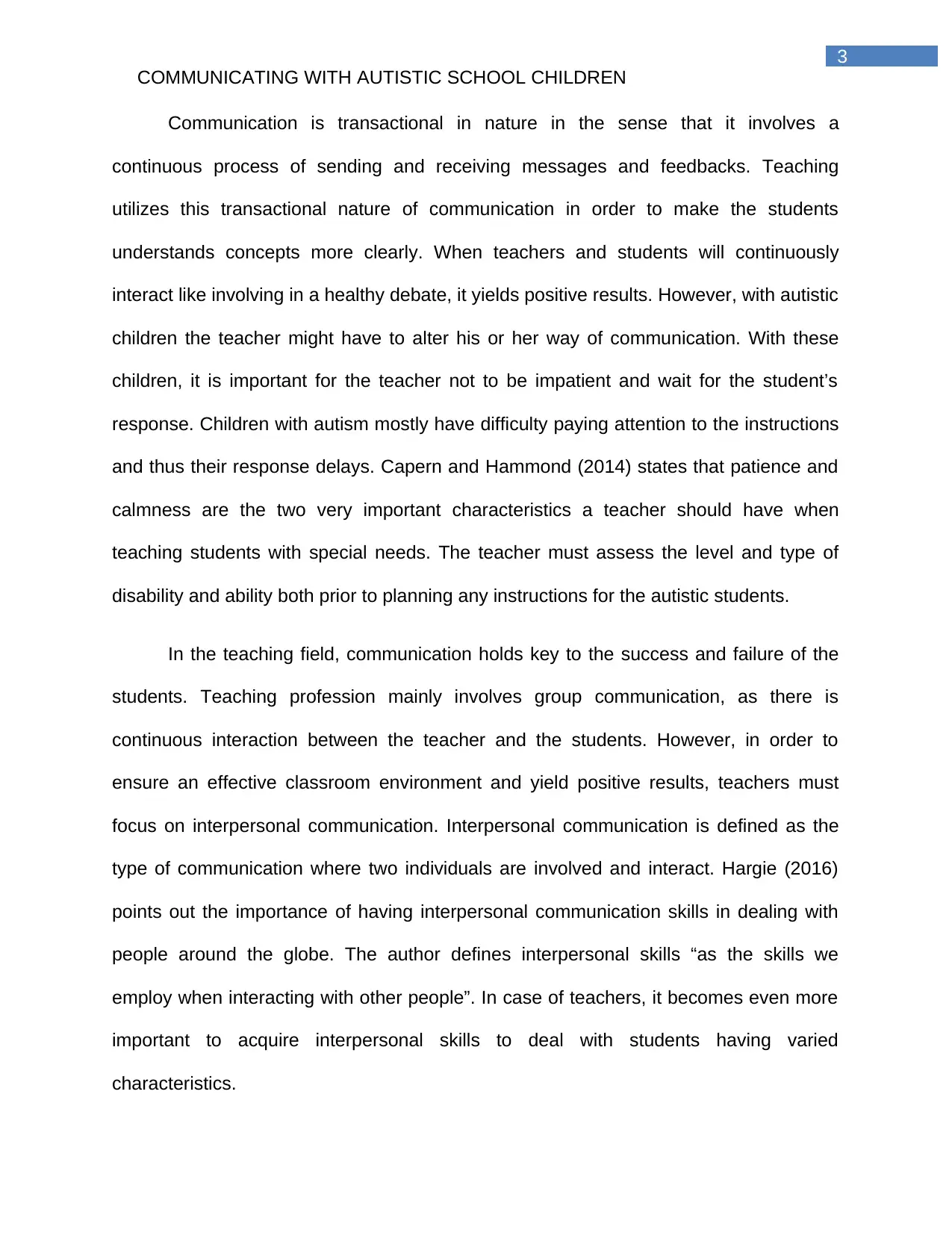
3
COMMUNICATING WITH AUTISTIC SCHOOL CHILDREN
Communication is transactional in nature in the sense that it involves a
continuous process of sending and receiving messages and feedbacks. Teaching
utilizes this transactional nature of communication in order to make the students
understands concepts more clearly. When teachers and students will continuously
interact like involving in a healthy debate, it yields positive results. However, with autistic
children the teacher might have to alter his or her way of communication. With these
children, it is important for the teacher not to be impatient and wait for the student’s
response. Children with autism mostly have difficulty paying attention to the instructions
and thus their response delays. Capern and Hammond (2014) states that patience and
calmness are the two very important characteristics a teacher should have when
teaching students with special needs. The teacher must assess the level and type of
disability and ability both prior to planning any instructions for the autistic students.
In the teaching field, communication holds key to the success and failure of the
students. Teaching profession mainly involves group communication, as there is
continuous interaction between the teacher and the students. However, in order to
ensure an effective classroom environment and yield positive results, teachers must
focus on interpersonal communication. Interpersonal communication is defined as the
type of communication where two individuals are involved and interact. Hargie (2016)
points out the importance of having interpersonal communication skills in dealing with
people around the globe. The author defines interpersonal skills “as the skills we
employ when interacting with other people”. In case of teachers, it becomes even more
important to acquire interpersonal skills to deal with students having varied
characteristics.
COMMUNICATING WITH AUTISTIC SCHOOL CHILDREN
Communication is transactional in nature in the sense that it involves a
continuous process of sending and receiving messages and feedbacks. Teaching
utilizes this transactional nature of communication in order to make the students
understands concepts more clearly. When teachers and students will continuously
interact like involving in a healthy debate, it yields positive results. However, with autistic
children the teacher might have to alter his or her way of communication. With these
children, it is important for the teacher not to be impatient and wait for the student’s
response. Children with autism mostly have difficulty paying attention to the instructions
and thus their response delays. Capern and Hammond (2014) states that patience and
calmness are the two very important characteristics a teacher should have when
teaching students with special needs. The teacher must assess the level and type of
disability and ability both prior to planning any instructions for the autistic students.
In the teaching field, communication holds key to the success and failure of the
students. Teaching profession mainly involves group communication, as there is
continuous interaction between the teacher and the students. However, in order to
ensure an effective classroom environment and yield positive results, teachers must
focus on interpersonal communication. Interpersonal communication is defined as the
type of communication where two individuals are involved and interact. Hargie (2016)
points out the importance of having interpersonal communication skills in dealing with
people around the globe. The author defines interpersonal skills “as the skills we
employ when interacting with other people”. In case of teachers, it becomes even more
important to acquire interpersonal skills to deal with students having varied
characteristics.
Paraphrase This Document
Need a fresh take? Get an instant paraphrase of this document with our AI Paraphraser
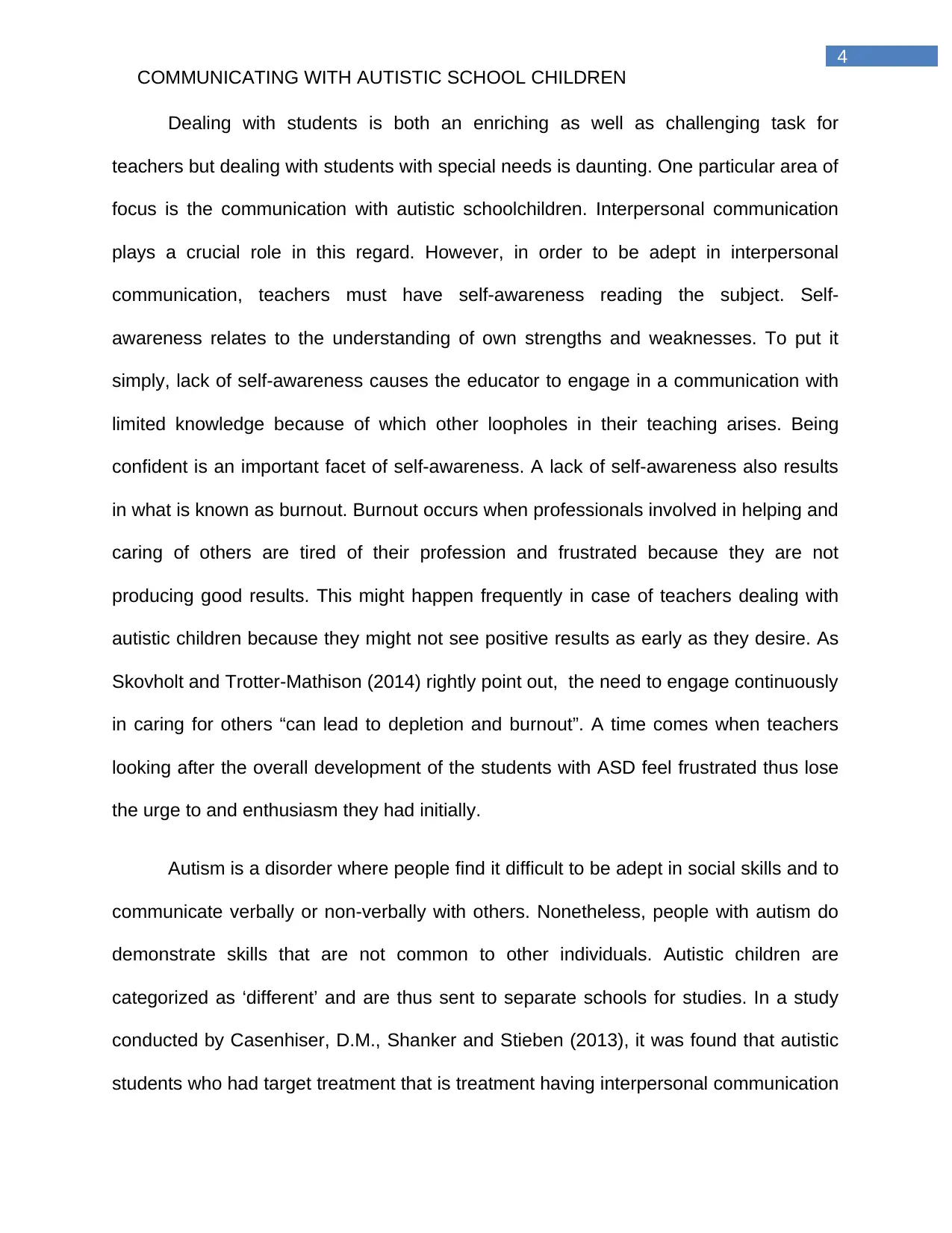
4
COMMUNICATING WITH AUTISTIC SCHOOL CHILDREN
Dealing with students is both an enriching as well as challenging task for
teachers but dealing with students with special needs is daunting. One particular area of
focus is the communication with autistic schoolchildren. Interpersonal communication
plays a crucial role in this regard. However, in order to be adept in interpersonal
communication, teachers must have self-awareness reading the subject. Self-
awareness relates to the understanding of own strengths and weaknesses. To put it
simply, lack of self-awareness causes the educator to engage in a communication with
limited knowledge because of which other loopholes in their teaching arises. Being
confident is an important facet of self-awareness. A lack of self-awareness also results
in what is known as burnout. Burnout occurs when professionals involved in helping and
caring of others are tired of their profession and frustrated because they are not
producing good results. This might happen frequently in case of teachers dealing with
autistic children because they might not see positive results as early as they desire. As
Skovholt and Trotter-Mathison (2014) rightly point out, the need to engage continuously
in caring for others “can lead to depletion and burnout”. A time comes when teachers
looking after the overall development of the students with ASD feel frustrated thus lose
the urge to and enthusiasm they had initially.
Autism is a disorder where people find it difficult to be adept in social skills and to
communicate verbally or non-verbally with others. Nonetheless, people with autism do
demonstrate skills that are not common to other individuals. Autistic children are
categorized as ‘different’ and are thus sent to separate schools for studies. In a study
conducted by Casenhiser, D.M., Shanker and Stieben (2013), it was found that autistic
students who had target treatment that is treatment having interpersonal communication
COMMUNICATING WITH AUTISTIC SCHOOL CHILDREN
Dealing with students is both an enriching as well as challenging task for
teachers but dealing with students with special needs is daunting. One particular area of
focus is the communication with autistic schoolchildren. Interpersonal communication
plays a crucial role in this regard. However, in order to be adept in interpersonal
communication, teachers must have self-awareness reading the subject. Self-
awareness relates to the understanding of own strengths and weaknesses. To put it
simply, lack of self-awareness causes the educator to engage in a communication with
limited knowledge because of which other loopholes in their teaching arises. Being
confident is an important facet of self-awareness. A lack of self-awareness also results
in what is known as burnout. Burnout occurs when professionals involved in helping and
caring of others are tired of their profession and frustrated because they are not
producing good results. This might happen frequently in case of teachers dealing with
autistic children because they might not see positive results as early as they desire. As
Skovholt and Trotter-Mathison (2014) rightly point out, the need to engage continuously
in caring for others “can lead to depletion and burnout”. A time comes when teachers
looking after the overall development of the students with ASD feel frustrated thus lose
the urge to and enthusiasm they had initially.
Autism is a disorder where people find it difficult to be adept in social skills and to
communicate verbally or non-verbally with others. Nonetheless, people with autism do
demonstrate skills that are not common to other individuals. Autistic children are
categorized as ‘different’ and are thus sent to separate schools for studies. In a study
conducted by Casenhiser, D.M., Shanker and Stieben (2013), it was found that autistic
students who had target treatment that is treatment having interpersonal communication
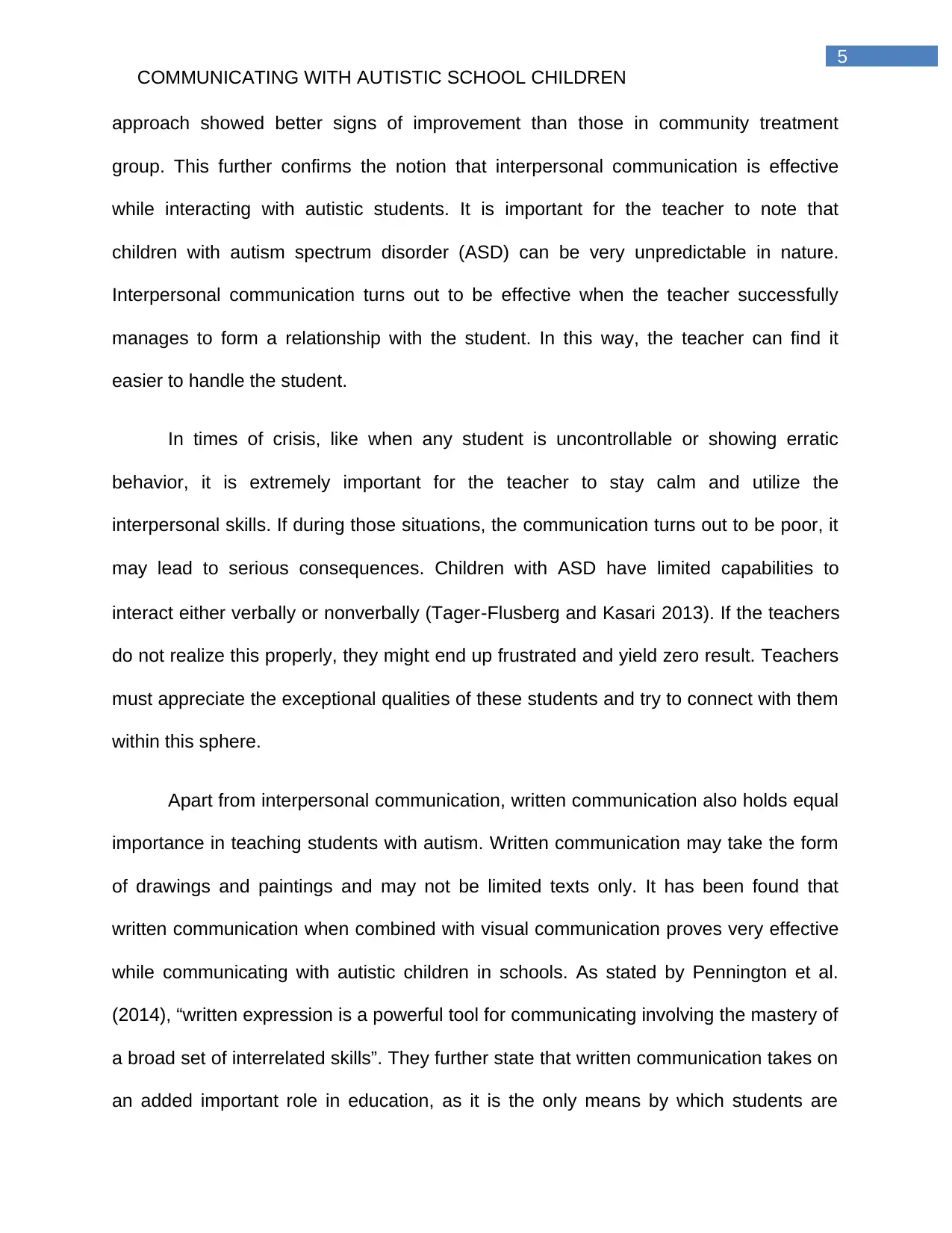
5
COMMUNICATING WITH AUTISTIC SCHOOL CHILDREN
approach showed better signs of improvement than those in community treatment
group. This further confirms the notion that interpersonal communication is effective
while interacting with autistic students. It is important for the teacher to note that
children with autism spectrum disorder (ASD) can be very unpredictable in nature.
Interpersonal communication turns out to be effective when the teacher successfully
manages to form a relationship with the student. In this way, the teacher can find it
easier to handle the student.
In times of crisis, like when any student is uncontrollable or showing erratic
behavior, it is extremely important for the teacher to stay calm and utilize the
interpersonal skills. If during those situations, the communication turns out to be poor, it
may lead to serious consequences. Children with ASD have limited capabilities to
interact either verbally or nonverbally (Tager‐Flusberg and Kasari 2013). If the teachers
do not realize this properly, they might end up frustrated and yield zero result. Teachers
must appreciate the exceptional qualities of these students and try to connect with them
within this sphere.
Apart from interpersonal communication, written communication also holds equal
importance in teaching students with autism. Written communication may take the form
of drawings and paintings and may not be limited texts only. It has been found that
written communication when combined with visual communication proves very effective
while communicating with autistic children in schools. As stated by Pennington et al.
(2014), “written expression is a powerful tool for communicating involving the mastery of
a broad set of interrelated skills”. They further state that written communication takes on
an added important role in education, as it is the only means by which students are
COMMUNICATING WITH AUTISTIC SCHOOL CHILDREN
approach showed better signs of improvement than those in community treatment
group. This further confirms the notion that interpersonal communication is effective
while interacting with autistic students. It is important for the teacher to note that
children with autism spectrum disorder (ASD) can be very unpredictable in nature.
Interpersonal communication turns out to be effective when the teacher successfully
manages to form a relationship with the student. In this way, the teacher can find it
easier to handle the student.
In times of crisis, like when any student is uncontrollable or showing erratic
behavior, it is extremely important for the teacher to stay calm and utilize the
interpersonal skills. If during those situations, the communication turns out to be poor, it
may lead to serious consequences. Children with ASD have limited capabilities to
interact either verbally or nonverbally (Tager‐Flusberg and Kasari 2013). If the teachers
do not realize this properly, they might end up frustrated and yield zero result. Teachers
must appreciate the exceptional qualities of these students and try to connect with them
within this sphere.
Apart from interpersonal communication, written communication also holds equal
importance in teaching students with autism. Written communication may take the form
of drawings and paintings and may not be limited texts only. It has been found that
written communication when combined with visual communication proves very effective
while communicating with autistic children in schools. As stated by Pennington et al.
(2014), “written expression is a powerful tool for communicating involving the mastery of
a broad set of interrelated skills”. They further state that written communication takes on
an added important role in education, as it is the only means by which students are
⊘ This is a preview!⊘
Do you want full access?
Subscribe today to unlock all pages.

Trusted by 1+ million students worldwide
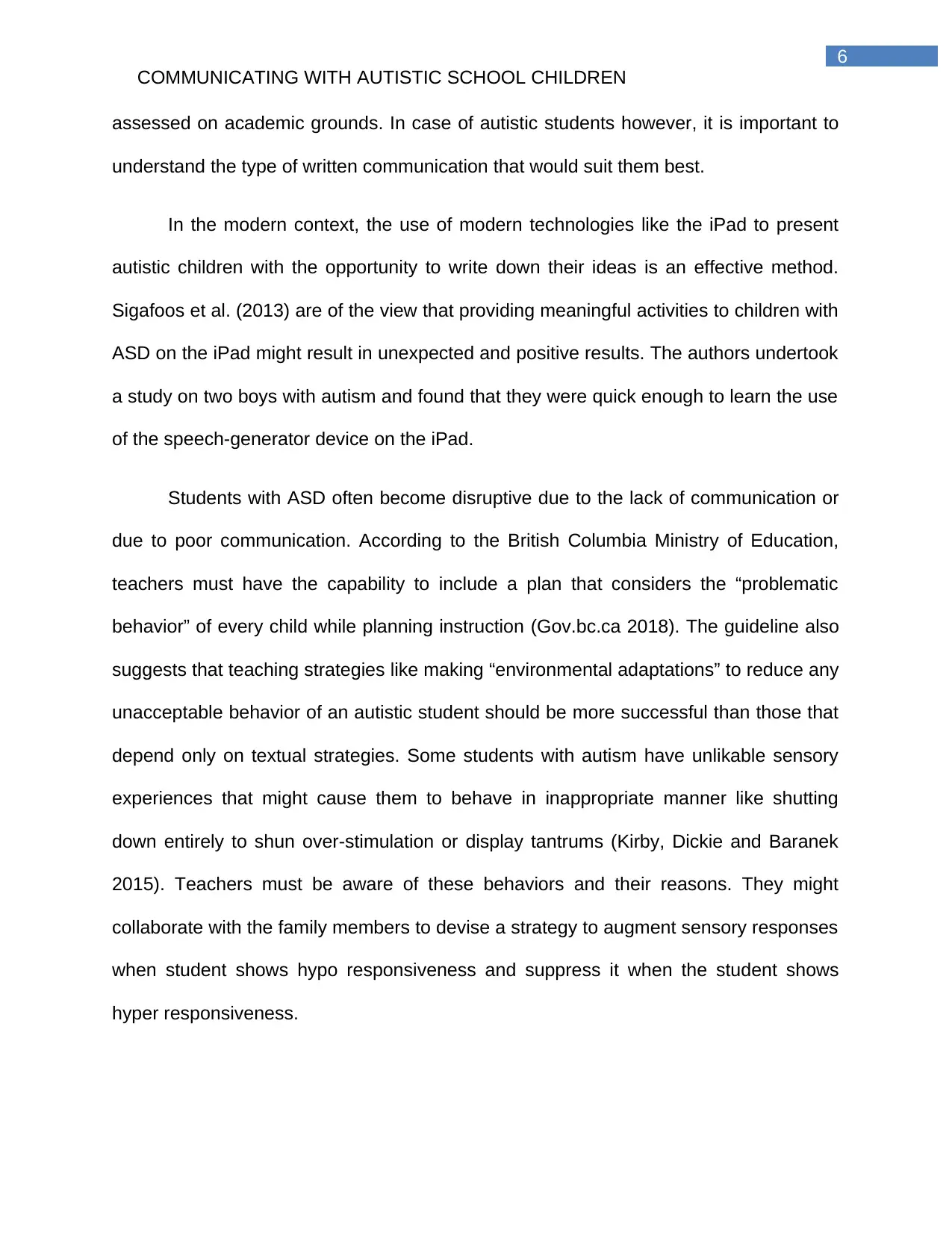
6
COMMUNICATING WITH AUTISTIC SCHOOL CHILDREN
assessed on academic grounds. In case of autistic students however, it is important to
understand the type of written communication that would suit them best.
In the modern context, the use of modern technologies like the iPad to present
autistic children with the opportunity to write down their ideas is an effective method.
Sigafoos et al. (2013) are of the view that providing meaningful activities to children with
ASD on the iPad might result in unexpected and positive results. The authors undertook
a study on two boys with autism and found that they were quick enough to learn the use
of the speech-generator device on the iPad.
Students with ASD often become disruptive due to the lack of communication or
due to poor communication. According to the British Columbia Ministry of Education,
teachers must have the capability to include a plan that considers the “problematic
behavior” of every child while planning instruction (Gov.bc.ca 2018). The guideline also
suggests that teaching strategies like making “environmental adaptations” to reduce any
unacceptable behavior of an autistic student should be more successful than those that
depend only on textual strategies. Some students with autism have unlikable sensory
experiences that might cause them to behave in inappropriate manner like shutting
down entirely to shun over-stimulation or display tantrums (Kirby, Dickie and Baranek
2015). Teachers must be aware of these behaviors and their reasons. They might
collaborate with the family members to devise a strategy to augment sensory responses
when student shows hypo responsiveness and suppress it when the student shows
hyper responsiveness.
COMMUNICATING WITH AUTISTIC SCHOOL CHILDREN
assessed on academic grounds. In case of autistic students however, it is important to
understand the type of written communication that would suit them best.
In the modern context, the use of modern technologies like the iPad to present
autistic children with the opportunity to write down their ideas is an effective method.
Sigafoos et al. (2013) are of the view that providing meaningful activities to children with
ASD on the iPad might result in unexpected and positive results. The authors undertook
a study on two boys with autism and found that they were quick enough to learn the use
of the speech-generator device on the iPad.
Students with ASD often become disruptive due to the lack of communication or
due to poor communication. According to the British Columbia Ministry of Education,
teachers must have the capability to include a plan that considers the “problematic
behavior” of every child while planning instruction (Gov.bc.ca 2018). The guideline also
suggests that teaching strategies like making “environmental adaptations” to reduce any
unacceptable behavior of an autistic student should be more successful than those that
depend only on textual strategies. Some students with autism have unlikable sensory
experiences that might cause them to behave in inappropriate manner like shutting
down entirely to shun over-stimulation or display tantrums (Kirby, Dickie and Baranek
2015). Teachers must be aware of these behaviors and their reasons. They might
collaborate with the family members to devise a strategy to augment sensory responses
when student shows hypo responsiveness and suppress it when the student shows
hyper responsiveness.
Paraphrase This Document
Need a fresh take? Get an instant paraphrase of this document with our AI Paraphraser
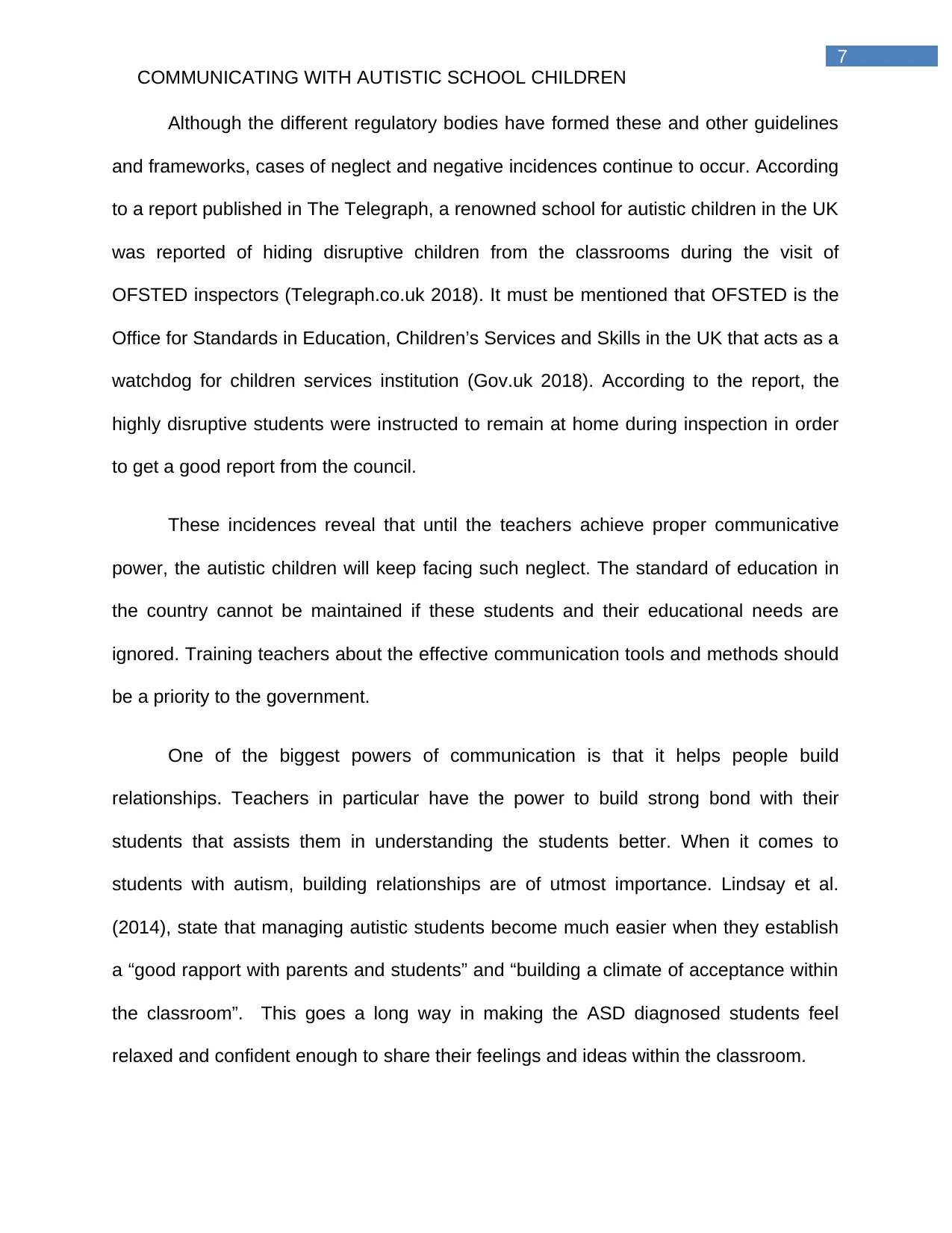
7
COMMUNICATING WITH AUTISTIC SCHOOL CHILDREN
Although the different regulatory bodies have formed these and other guidelines
and frameworks, cases of neglect and negative incidences continue to occur. According
to a report published in The Telegraph, a renowned school for autistic children in the UK
was reported of hiding disruptive children from the classrooms during the visit of
OFSTED inspectors (Telegraph.co.uk 2018). It must be mentioned that OFSTED is the
Office for Standards in Education, Children’s Services and Skills in the UK that acts as a
watchdog for children services institution (Gov.uk 2018). According to the report, the
highly disruptive students were instructed to remain at home during inspection in order
to get a good report from the council.
These incidences reveal that until the teachers achieve proper communicative
power, the autistic children will keep facing such neglect. The standard of education in
the country cannot be maintained if these students and their educational needs are
ignored. Training teachers about the effective communication tools and methods should
be a priority to the government.
One of the biggest powers of communication is that it helps people build
relationships. Teachers in particular have the power to build strong bond with their
students that assists them in understanding the students better. When it comes to
students with autism, building relationships are of utmost importance. Lindsay et al.
(2014), state that managing autistic students become much easier when they establish
a “good rapport with parents and students” and “building a climate of acceptance within
the classroom”. This goes a long way in making the ASD diagnosed students feel
relaxed and confident enough to share their feelings and ideas within the classroom.
COMMUNICATING WITH AUTISTIC SCHOOL CHILDREN
Although the different regulatory bodies have formed these and other guidelines
and frameworks, cases of neglect and negative incidences continue to occur. According
to a report published in The Telegraph, a renowned school for autistic children in the UK
was reported of hiding disruptive children from the classrooms during the visit of
OFSTED inspectors (Telegraph.co.uk 2018). It must be mentioned that OFSTED is the
Office for Standards in Education, Children’s Services and Skills in the UK that acts as a
watchdog for children services institution (Gov.uk 2018). According to the report, the
highly disruptive students were instructed to remain at home during inspection in order
to get a good report from the council.
These incidences reveal that until the teachers achieve proper communicative
power, the autistic children will keep facing such neglect. The standard of education in
the country cannot be maintained if these students and their educational needs are
ignored. Training teachers about the effective communication tools and methods should
be a priority to the government.
One of the biggest powers of communication is that it helps people build
relationships. Teachers in particular have the power to build strong bond with their
students that assists them in understanding the students better. When it comes to
students with autism, building relationships are of utmost importance. Lindsay et al.
(2014), state that managing autistic students become much easier when they establish
a “good rapport with parents and students” and “building a climate of acceptance within
the classroom”. This goes a long way in making the ASD diagnosed students feel
relaxed and confident enough to share their feelings and ideas within the classroom.
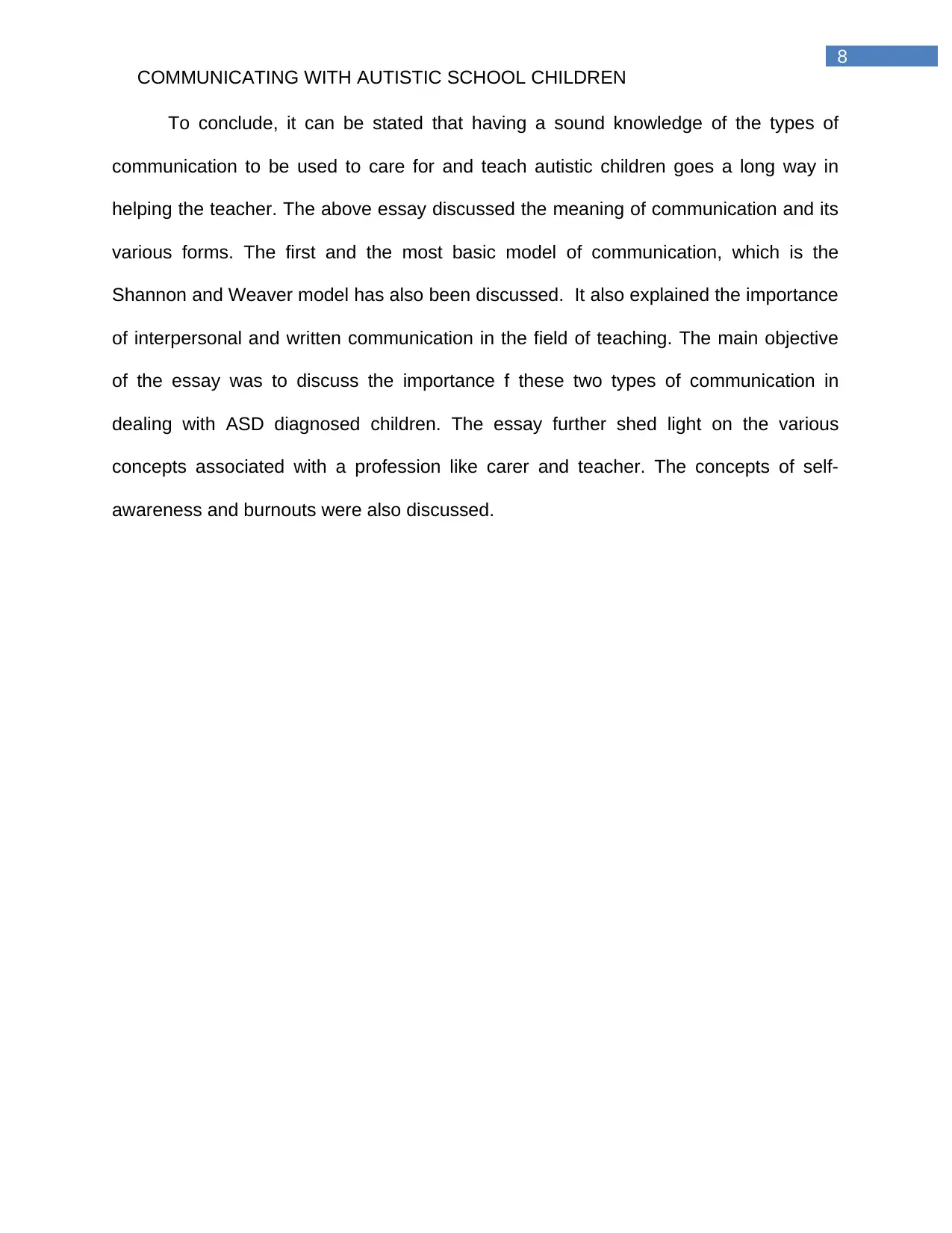
8
COMMUNICATING WITH AUTISTIC SCHOOL CHILDREN
To conclude, it can be stated that having a sound knowledge of the types of
communication to be used to care for and teach autistic children goes a long way in
helping the teacher. The above essay discussed the meaning of communication and its
various forms. The first and the most basic model of communication, which is the
Shannon and Weaver model has also been discussed. It also explained the importance
of interpersonal and written communication in the field of teaching. The main objective
of the essay was to discuss the importance f these two types of communication in
dealing with ASD diagnosed children. The essay further shed light on the various
concepts associated with a profession like carer and teacher. The concepts of self-
awareness and burnouts were also discussed.
COMMUNICATING WITH AUTISTIC SCHOOL CHILDREN
To conclude, it can be stated that having a sound knowledge of the types of
communication to be used to care for and teach autistic children goes a long way in
helping the teacher. The above essay discussed the meaning of communication and its
various forms. The first and the most basic model of communication, which is the
Shannon and Weaver model has also been discussed. It also explained the importance
of interpersonal and written communication in the field of teaching. The main objective
of the essay was to discuss the importance f these two types of communication in
dealing with ASD diagnosed children. The essay further shed light on the various
concepts associated with a profession like carer and teacher. The concepts of self-
awareness and burnouts were also discussed.
⊘ This is a preview!⊘
Do you want full access?
Subscribe today to unlock all pages.

Trusted by 1+ million students worldwide
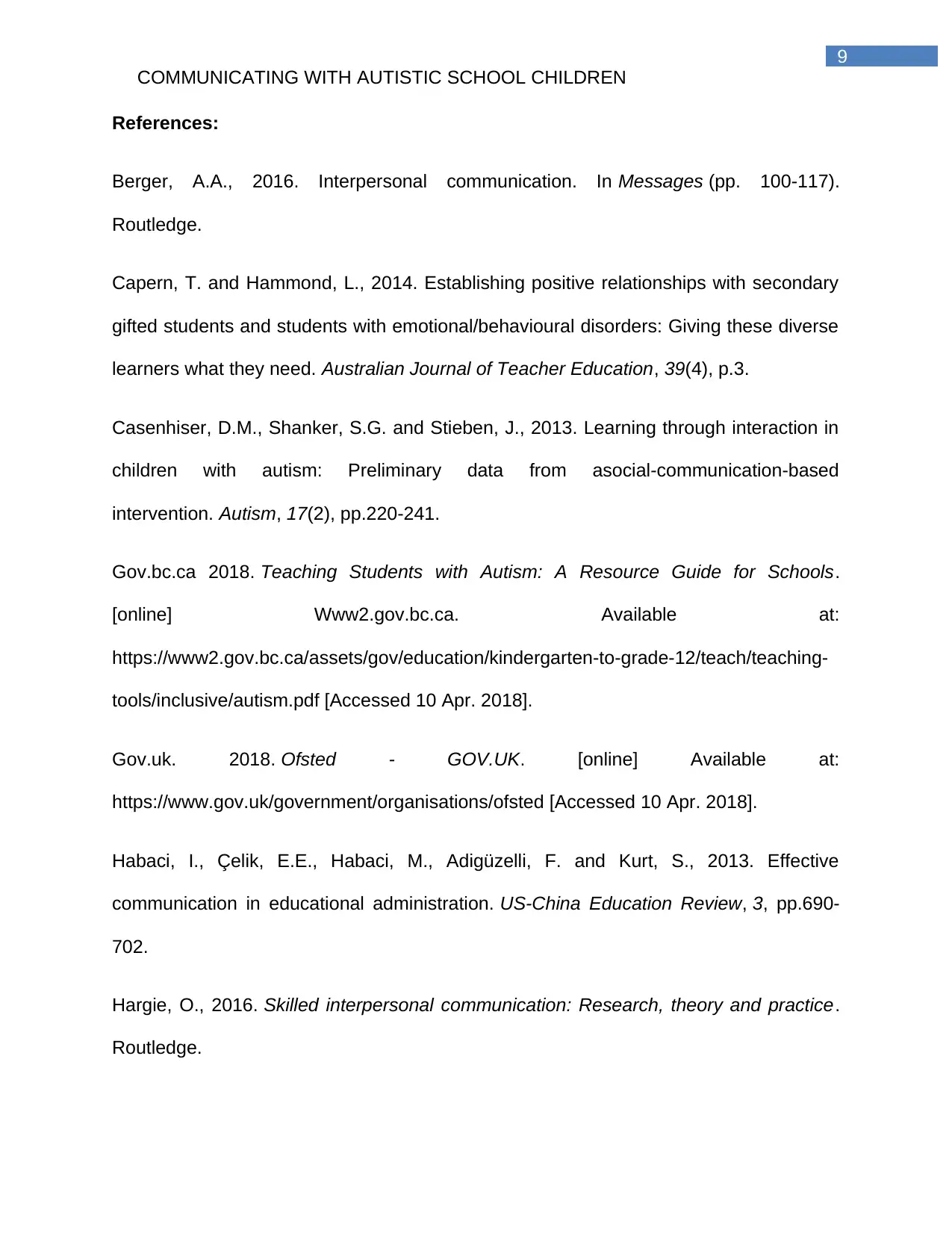
9
COMMUNICATING WITH AUTISTIC SCHOOL CHILDREN
References:
Berger, A.A., 2016. Interpersonal communication. In Messages (pp. 100-117).
Routledge.
Capern, T. and Hammond, L., 2014. Establishing positive relationships with secondary
gifted students and students with emotional/behavioural disorders: Giving these diverse
learners what they need. Australian Journal of Teacher Education, 39(4), p.3.
Casenhiser, D.M., Shanker, S.G. and Stieben, J., 2013. Learning through interaction in
children with autism: Preliminary data from asocial-communication-based
intervention. Autism, 17(2), pp.220-241.
Gov.bc.ca 2018. Teaching Students with Autism: A Resource Guide for Schools.
[online] Www2.gov.bc.ca. Available at:
https://www2.gov.bc.ca/assets/gov/education/kindergarten-to-grade-12/teach/teaching-
tools/inclusive/autism.pdf [Accessed 10 Apr. 2018].
Gov.uk. 2018. Ofsted - GOV.UK. [online] Available at:
https://www.gov.uk/government/organisations/ofsted [Accessed 10 Apr. 2018].
Habaci, I., Çelik, E.E., Habaci, M., Adigüzelli, F. and Kurt, S., 2013. Effective
communication in educational administration. US-China Education Review, 3, pp.690-
702.
Hargie, O., 2016. Skilled interpersonal communication: Research, theory and practice.
Routledge.
COMMUNICATING WITH AUTISTIC SCHOOL CHILDREN
References:
Berger, A.A., 2016. Interpersonal communication. In Messages (pp. 100-117).
Routledge.
Capern, T. and Hammond, L., 2014. Establishing positive relationships with secondary
gifted students and students with emotional/behavioural disorders: Giving these diverse
learners what they need. Australian Journal of Teacher Education, 39(4), p.3.
Casenhiser, D.M., Shanker, S.G. and Stieben, J., 2013. Learning through interaction in
children with autism: Preliminary data from asocial-communication-based
intervention. Autism, 17(2), pp.220-241.
Gov.bc.ca 2018. Teaching Students with Autism: A Resource Guide for Schools.
[online] Www2.gov.bc.ca. Available at:
https://www2.gov.bc.ca/assets/gov/education/kindergarten-to-grade-12/teach/teaching-
tools/inclusive/autism.pdf [Accessed 10 Apr. 2018].
Gov.uk. 2018. Ofsted - GOV.UK. [online] Available at:
https://www.gov.uk/government/organisations/ofsted [Accessed 10 Apr. 2018].
Habaci, I., Çelik, E.E., Habaci, M., Adigüzelli, F. and Kurt, S., 2013. Effective
communication in educational administration. US-China Education Review, 3, pp.690-
702.
Hargie, O., 2016. Skilled interpersonal communication: Research, theory and practice.
Routledge.
Paraphrase This Document
Need a fresh take? Get an instant paraphrase of this document with our AI Paraphraser
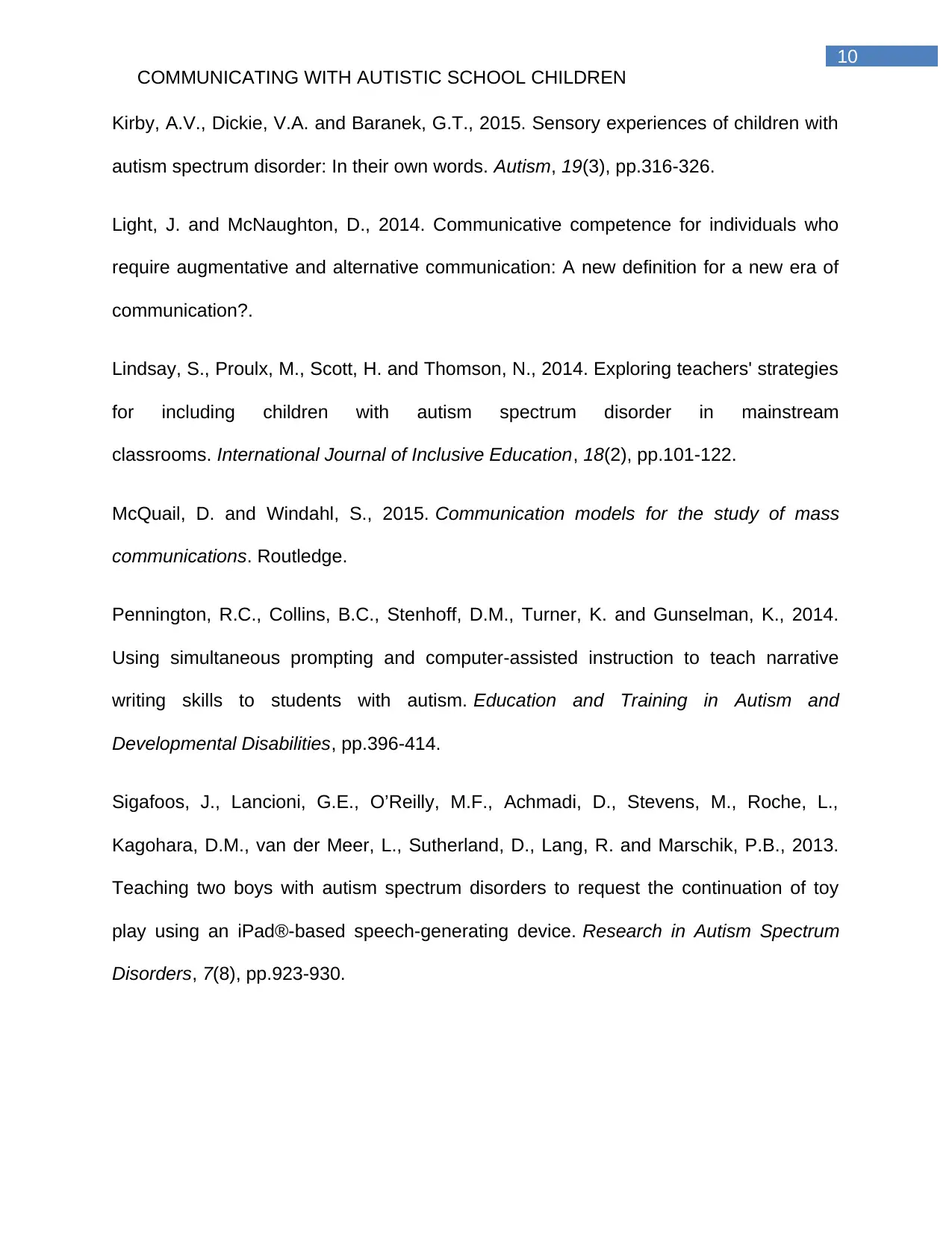
10
COMMUNICATING WITH AUTISTIC SCHOOL CHILDREN
Kirby, A.V., Dickie, V.A. and Baranek, G.T., 2015. Sensory experiences of children with
autism spectrum disorder: In their own words. Autism, 19(3), pp.316-326.
Light, J. and McNaughton, D., 2014. Communicative competence for individuals who
require augmentative and alternative communication: A new definition for a new era of
communication?.
Lindsay, S., Proulx, M., Scott, H. and Thomson, N., 2014. Exploring teachers' strategies
for including children with autism spectrum disorder in mainstream
classrooms. International Journal of Inclusive Education, 18(2), pp.101-122.
McQuail, D. and Windahl, S., 2015. Communication models for the study of mass
communications. Routledge.
Pennington, R.C., Collins, B.C., Stenhoff, D.M., Turner, K. and Gunselman, K., 2014.
Using simultaneous prompting and computer-assisted instruction to teach narrative
writing skills to students with autism. Education and Training in Autism and
Developmental Disabilities, pp.396-414.
Sigafoos, J., Lancioni, G.E., O’Reilly, M.F., Achmadi, D., Stevens, M., Roche, L.,
Kagohara, D.M., van der Meer, L., Sutherland, D., Lang, R. and Marschik, P.B., 2013.
Teaching two boys with autism spectrum disorders to request the continuation of toy
play using an iPad®-based speech-generating device. Research in Autism Spectrum
Disorders, 7(8), pp.923-930.
COMMUNICATING WITH AUTISTIC SCHOOL CHILDREN
Kirby, A.V., Dickie, V.A. and Baranek, G.T., 2015. Sensory experiences of children with
autism spectrum disorder: In their own words. Autism, 19(3), pp.316-326.
Light, J. and McNaughton, D., 2014. Communicative competence for individuals who
require augmentative and alternative communication: A new definition for a new era of
communication?.
Lindsay, S., Proulx, M., Scott, H. and Thomson, N., 2014. Exploring teachers' strategies
for including children with autism spectrum disorder in mainstream
classrooms. International Journal of Inclusive Education, 18(2), pp.101-122.
McQuail, D. and Windahl, S., 2015. Communication models for the study of mass
communications. Routledge.
Pennington, R.C., Collins, B.C., Stenhoff, D.M., Turner, K. and Gunselman, K., 2014.
Using simultaneous prompting and computer-assisted instruction to teach narrative
writing skills to students with autism. Education and Training in Autism and
Developmental Disabilities, pp.396-414.
Sigafoos, J., Lancioni, G.E., O’Reilly, M.F., Achmadi, D., Stevens, M., Roche, L.,
Kagohara, D.M., van der Meer, L., Sutherland, D., Lang, R. and Marschik, P.B., 2013.
Teaching two boys with autism spectrum disorders to request the continuation of toy
play using an iPad®-based speech-generating device. Research in Autism Spectrum
Disorders, 7(8), pp.923-930.
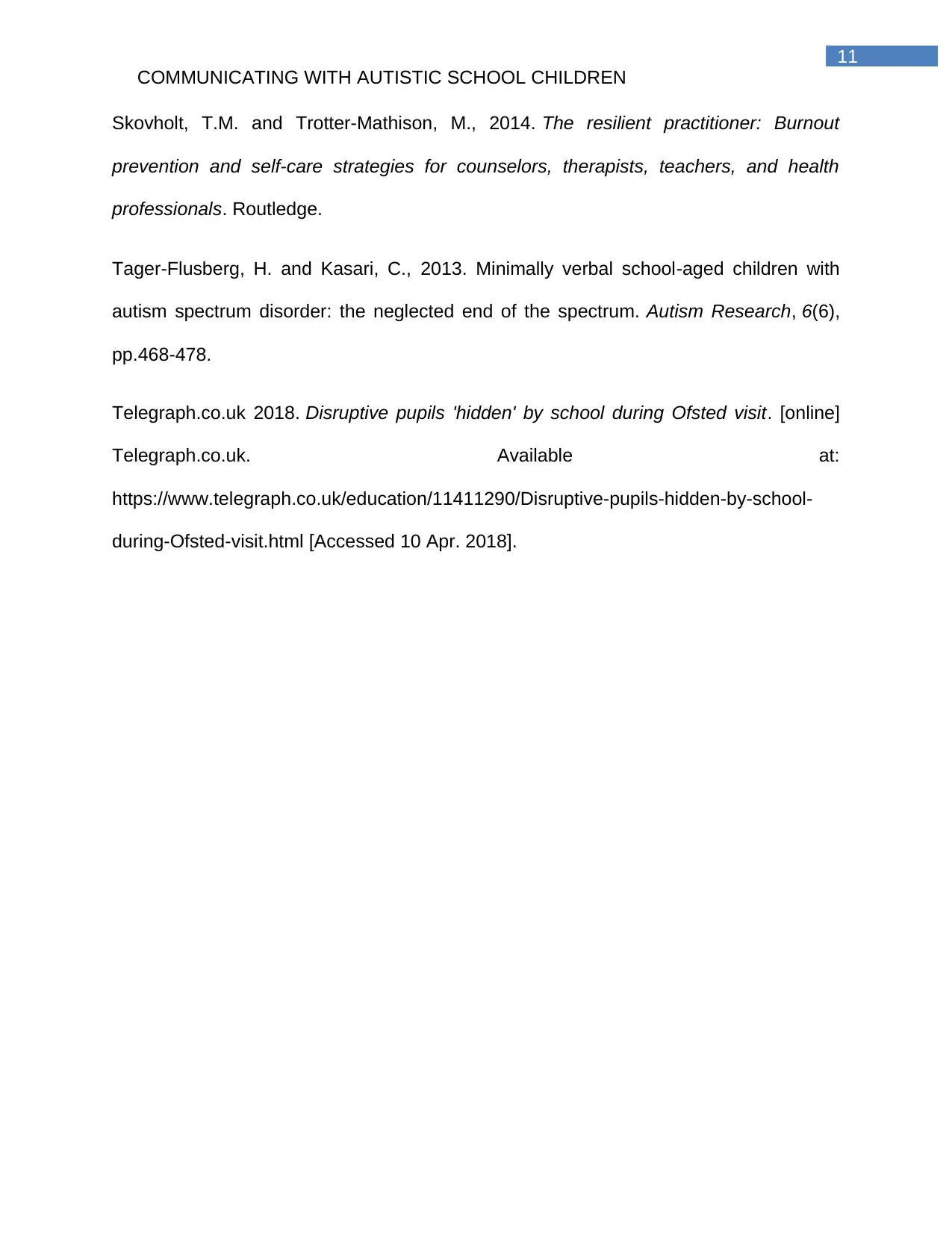
11
COMMUNICATING WITH AUTISTIC SCHOOL CHILDREN
Skovholt, T.M. and Trotter-Mathison, M., 2014. The resilient practitioner: Burnout
prevention and self-care strategies for counselors, therapists, teachers, and health
professionals. Routledge.
Tager‐Flusberg, H. and Kasari, C., 2013. Minimally verbal school‐aged children with
autism spectrum disorder: the neglected end of the spectrum. Autism Research, 6(6),
pp.468-478.
Telegraph.co.uk 2018. Disruptive pupils 'hidden' by school during Ofsted visit. [online]
Telegraph.co.uk. Available at:
https://www.telegraph.co.uk/education/11411290/Disruptive-pupils-hidden-by-school-
during-Ofsted-visit.html [Accessed 10 Apr. 2018].
COMMUNICATING WITH AUTISTIC SCHOOL CHILDREN
Skovholt, T.M. and Trotter-Mathison, M., 2014. The resilient practitioner: Burnout
prevention and self-care strategies for counselors, therapists, teachers, and health
professionals. Routledge.
Tager‐Flusberg, H. and Kasari, C., 2013. Minimally verbal school‐aged children with
autism spectrum disorder: the neglected end of the spectrum. Autism Research, 6(6),
pp.468-478.
Telegraph.co.uk 2018. Disruptive pupils 'hidden' by school during Ofsted visit. [online]
Telegraph.co.uk. Available at:
https://www.telegraph.co.uk/education/11411290/Disruptive-pupils-hidden-by-school-
during-Ofsted-visit.html [Accessed 10 Apr. 2018].
⊘ This is a preview!⊘
Do you want full access?
Subscribe today to unlock all pages.

Trusted by 1+ million students worldwide
1 out of 12
Related Documents
Your All-in-One AI-Powered Toolkit for Academic Success.
+13062052269
info@desklib.com
Available 24*7 on WhatsApp / Email
![[object Object]](/_next/static/media/star-bottom.7253800d.svg)
Unlock your academic potential
Copyright © 2020–2025 A2Z Services. All Rights Reserved. Developed and managed by ZUCOL.




